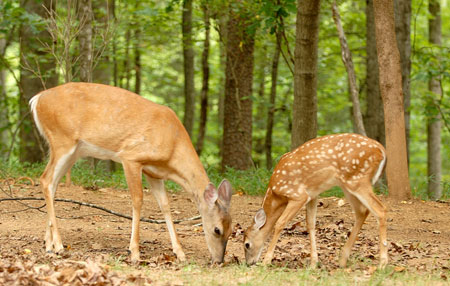Resources for Science Standard of Learning 2.4: Life Cycles
 The white-tailed deer is common throughout the Commonwealth. Whether you live in an urban, suburban, or rural area, with careful observation you should be able to see a deer feeding along a rural highway, in a park, or maybe in your yard.
The white-tailed deer is common throughout the Commonwealth. Whether you live in an urban, suburban, or rural area, with careful observation you should be able to see a deer feeding along a rural highway, in a park, or maybe in your yard.
For this reason and the natural interest that students have in the white-tailed deer, the Virginia Department of Education listed it as an example of a mammal’s life cycle. This page is designed to provide additional resources on Virginia’s deer for students and teachers.
The second grade science life cycle standard states:
2.4. The student will investigate and understand that plants and animals undergo a series of orderly changes as they mature and grow. Key concepts include
- animal life cycles; and
- plant life cycles.
The Curriculum Framework contains additional information for the teacher, and includes what students are expected to know about life cycles. Once you have linked to the second chapter of the Curriculum Framework, scroll through to page 14 to view Standard of Learning 2.4.
The Department of Wildlife Resources manages the white-tailed deer and all wildlife in Virginia. Deer are carefully managed through a fall hunting season and by making changes to the habitat on public lands. Hunters report all the deer that are taken during the season and the data is carefully reviewed by wildlife scientists to determine future management practices.
The life cycle of the deer is similar to other mammals, including people. As fawns, or infants, deer are very dependent on their mother or doe. Although they can stand and even run a few hours after birth, they stay hidden, growing stronger on their mother’s milk. Deer mature quickly and by one year, the yearling is on its own. If a yearling is a doe, she is ready to give birth to her first fawn.
Deer are edge animals, living in the area between deep woods and fields. The young tips of tree branches are a favorite food along with a variety of other plants including greenbrier and honey suckle. For a list of plants that either attract deer or are avoided by deer see the Deer Information page on this site.
Teacher resources that support SOL 2.4
- Deer by the Dozen: reprint of Virginia Wildlife “Wild in the Woods” article
- Where-is-the-Tooth-Fairy: students compare life cycles of the Virginia White-tailed Deer and Second Graders through the loss and eruption of teeth; and to understand how scientists use teeth and other aging methods to learn about the life cycles of different species.
- White-tailed Deer Coloring Sheets: coloring sheets of a fawn and a buck
- What-Happens-to-Deer-Antlers: students explore what happens to deer antlers in the wild Students conduct an investigation to discover what happens to antlers placed in various locations around the school.

